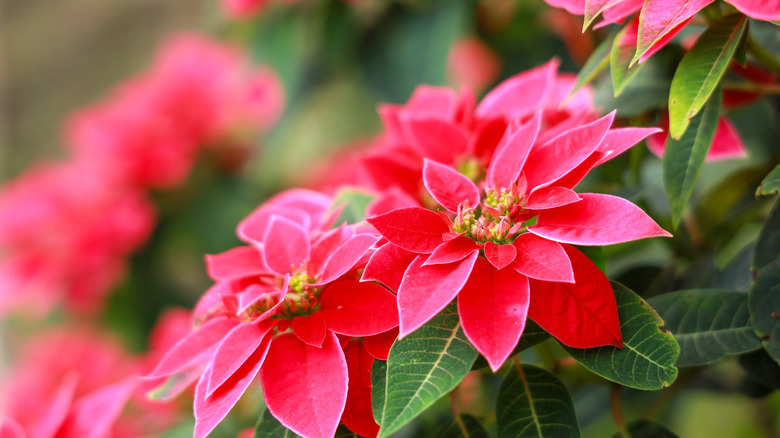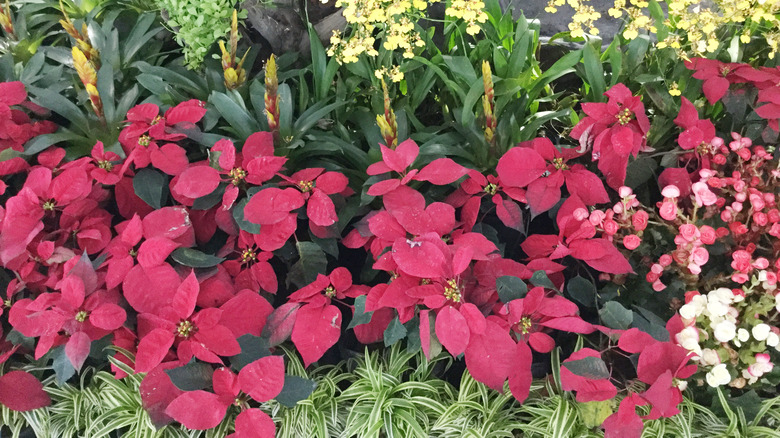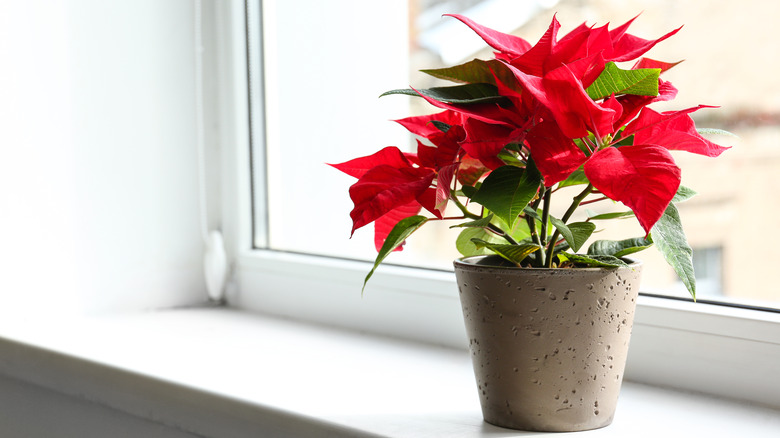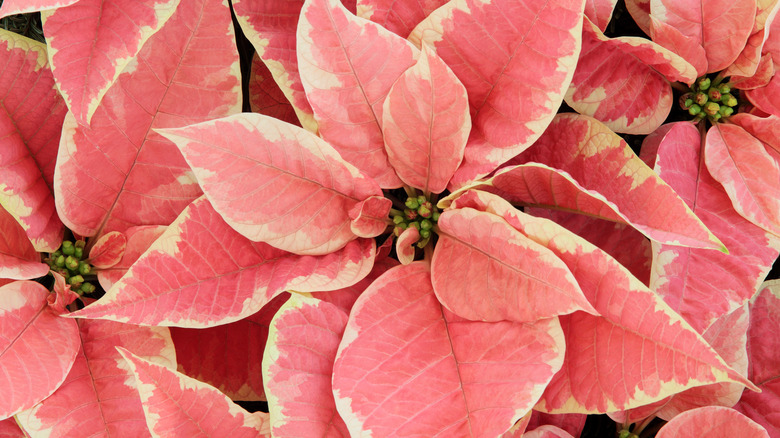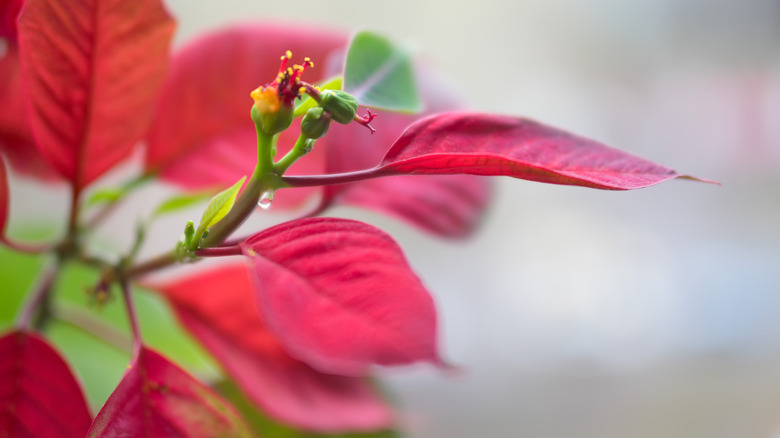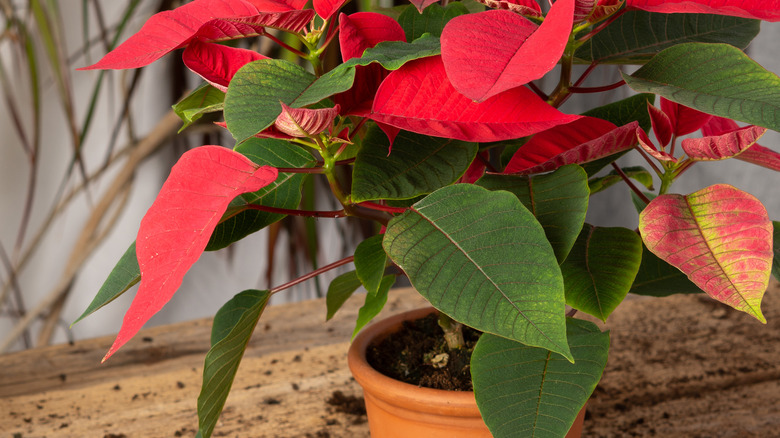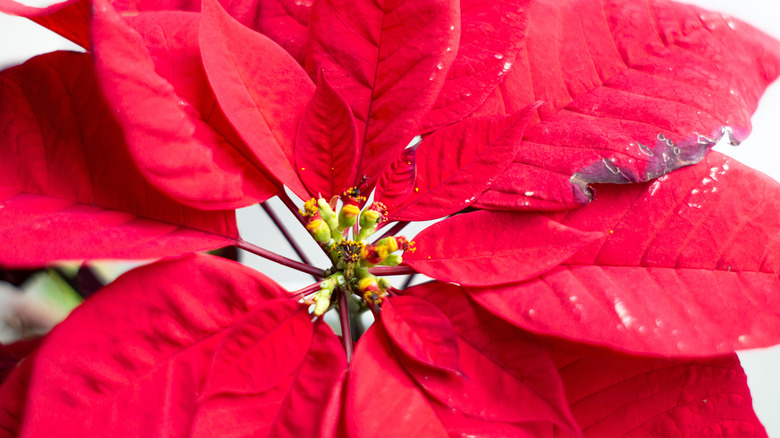Poinsettias: Everything You Should Know Before Planting
Poinsettias (Euphorbia pulcherrima), synonymous with the holiday season, are surprisingly tropical plants native to Mexico. From the Euphorbia family, their colors change as temperatures cool and days become shorter. The colorful parts of the plants that are often referred to as flowers are actually leaves, which are called bracts. The small yellow center of the "flowers" is called a cyathia, according to the University of Minnesota.
While you may only see them out during the holidays, you can keep poinsettias alive all year with a little tender loving care. If you do decide to move your plant outside, it needs to be in a sunny area where it will not be subjected to strong winds, which could result in damage. Just like when you grow them indoors, you need to plant them in slightly acidic soil that drains well so the roots won't rot. If the conditions are right, poinsettias can grow up to 10 feet tall (via Gardening Know How).
How to grow poinsettias
If you are planning to grow poinsettias outside, you should know that they thrive best in zones 9 through 11 on the Department of Agriculture zone chart. They can grow in cooler climates, but you will need to bring them inside before the first frost. The best time to propagate poinsettias is in the summer after the new growth begins at the base. Keep them in warm temperatures and bright light (via SF Gate).
It is important to propagate poinsettias in a clean container to avoid the plant stem coming into contact with any bacterial or fungal growths. Look to repot the small plants when they are three to five inches tall. Roots should begin to form within two to three weeks. When roots have formed, transplant the plant into a six inch deep pot with potting soil and keep it in a bright location. Water once a week.
How to care for poinsettias
To keep your poinsettia happy, it needs plenty of sunlight. If you can place it by an east- west-, or south-facing window, all the better. However, if you do keep your plant next to a window, make sure the leaves don't touch the glass because the chilly glass could cause them to fall off. Even though poinsettias may be tropical, they prefer temperatures on the cool side, generally 65 to 70 degrees Fahrenheit during daytime hours and 55 to 60 degrees Fahrenheit at night. Try to keep them in places where they won't experience severe drops in temperature, advises HGTV.
Poinsettias like loamy, well-drained soil that ranges from neutral to acidic. Water your plant when the soil feels dry, and add water until it begins to drain from the bottom. The soil should never be soaked nor should it be bone dry. If you keep your plant near a heater, check it frequently. When you water it, use water that is room temperature to slightly warm, and remove any water that is left in the drainer 10 minutes after watering, as per House Beautiful. If you are planning to keep your plant year-round, water it as needed from January through March (via University of Minnesota).
Varieties of poinsettias
When it comes to varieties of poinsettias, there are plenty of types to choose from. Around the holiday season, the plants with the traditional red bracts are the most common. However, you can also find different forms of the flowers, with some taking the shape of a rose, notes the University of Minnesota. Some types have three colors (usually red, white, and pink), and other breeds are purple. It is worth noting that some of the unusual colors, such as blue, will not bloom with the same colors because the bracts were dyed (via The Spruce).
Other varieties include the "ice punch" poinsettia, which features splashes of white down the center of red bracts. For a warmer tone, you may want to go with an orange poinsettia plant. "Rose marble" breeds feature a pink middle in the center of cream-colored bracts. The glitter varieties feature white specs on red bracts. Other options include pink, cinnamon, peach, and white, according to Sunset.
Are poinsettias toxic?
At one time, poinsettias were thought to be toxic, but they are not as harmful as once believed. If any part of the plant is ingested, it could cause a stomach ache, diarrhea, or vomiting. The sap of the plant can irritate skin, causing a mild rash. Wash any skin exposed with soap and water, and apply a cold pack to the area to alleviate itching. Additionally, if the sap gets into the eyes, it can cause redness and burning. If this occurs, rinse them with water, as noted by the Mayo Clinic. These same symptoms can happen to your pets, so keep them away from your plants, advises Purdue University.
Some people are allergic to poinsettias. Interestingly, people allergic to latex are often allergic to poinsettias because they both have some of the same proteins that cause reactions. In addition, if you are allergic to kiwis, bananas, avocados, or passion fruits, you might also be sensitive to poinsettias.
How to repot poinsettias
If you're planning on keeping your poinsettia after the holiday season, you'll need to transfer it into a larger pot as it grows over the winter. You will want to repot it in the late spring or early summer, according to Gardening Know How. Because the sap can cause skin irritation, it is best to wear gloves when working with the plants. When repotting, look for a pot that is about two inches larger than the one the plant is in. Make sure the pot has drainage holes, because the plants can fall victim to root rot if they stay.
Repot using a soil that contains peat moss, as per the University of Minnesota. If you are not sure about which type of potting soil to use, most houseplants tolerate a mix that is 70% peat moss and 30% perlite (via Well and Good). Trim the stems to about six inches tall to encourage new growth, as noted by New Mexico State University.
Troubleshooting common poinsettia problems
Poinsettias can fall victim to several ailments if conditions are not right. For starters, leaf edge burn usually results when poinsettias are not getting enough water. The leaves will wilt before the edges become brown and withered (via the University of Massachusetts).
Grey mold, fungal leaf spots, and powdery mildew, which look like dusty spots on leaves, can also stress plants. Typically these conditions are the result of poor circulation and high humidity. Remove the affected leaves and place the plant in an area where it will receive better circulation. If you notice spots on leaves with a yellow halo, avoid getting the leaves wet when watering, as noted by Texas A&M University.
If you notice the leaves turning yellow or falling off of your poinsettia, you may want to change how you water it. They do not like a lot of water, and too much will result in root and stem rot, which will eventually kill them. You should fertilize your poinsettia with a flowering houseplant fertilizer once a week beginning about a month after bringing it home, per House Beautiful.
